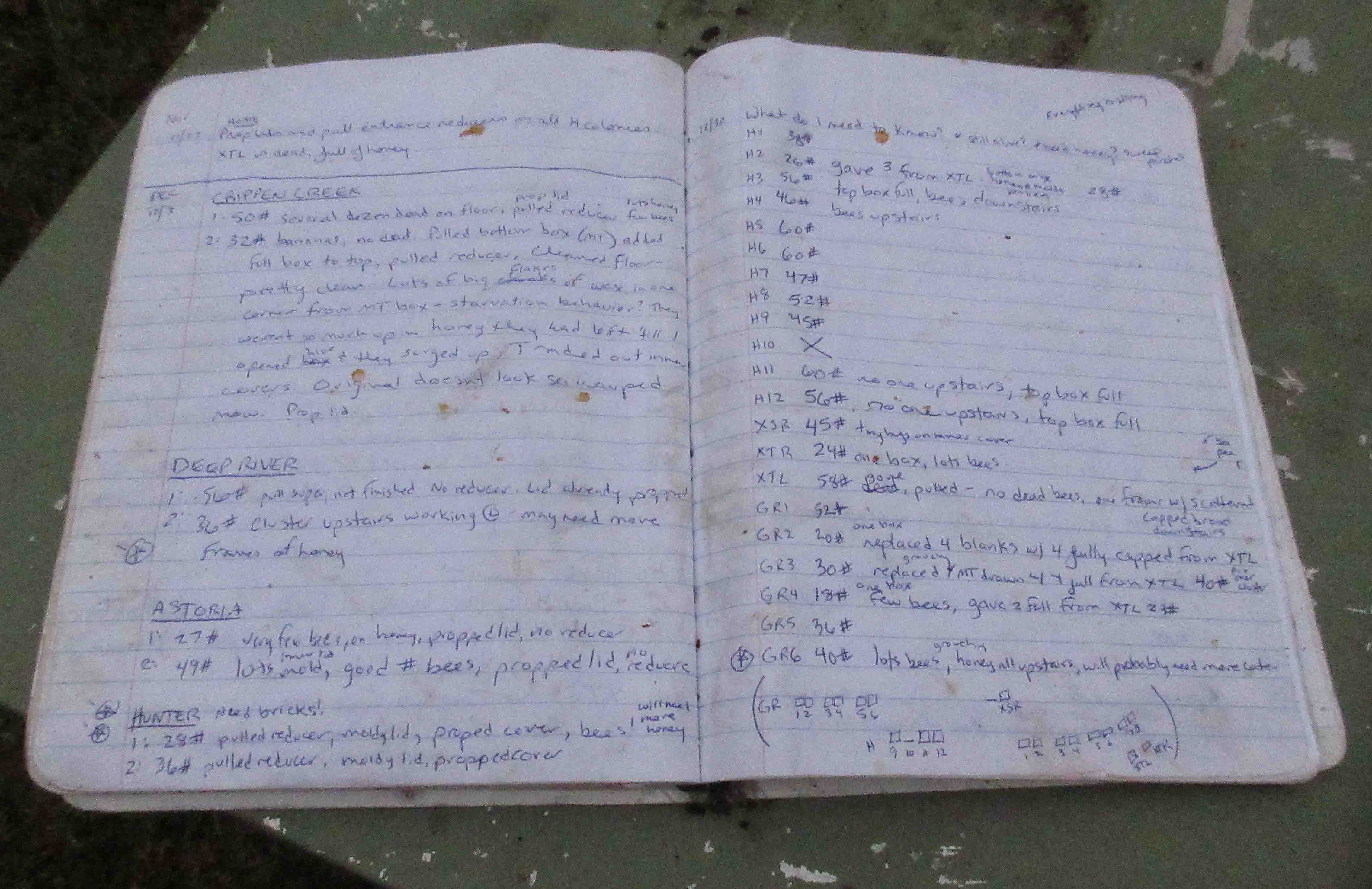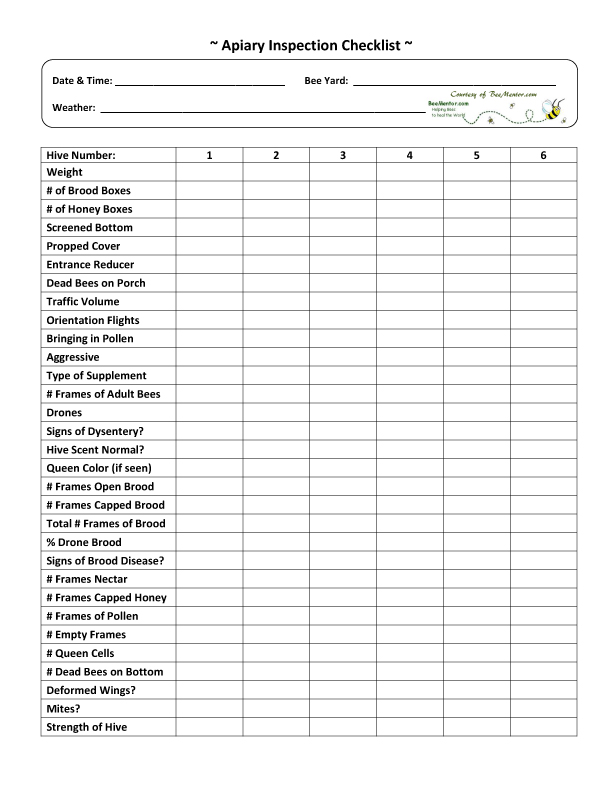 I filled up my first beekeeping journal in December, which got me thinking about record-keeping and how I might improve my system. I’ve been through a few iterations of record keeping systems, but the one I’ve been using the past five years is a mix of short notes and narrative. I record the date, location and hive number, then include notes that pertain to whatever it is I’m checking for that day. Here’s an example of a mid-winter inspection where I was checking colony vitality and stores:
I filled up my first beekeeping journal in December, which got me thinking about record-keeping and how I might improve my system. I’ve been through a few iterations of record keeping systems, but the one I’ve been using the past five years is a mix of short notes and narrative. I record the date, location and hive number, then include notes that pertain to whatever it is I’m checking for that day. Here’s an example of a mid-winter inspection where I was checking colony vitality and stores:
1/23/17: Deep River
1: 46# good cluster, lots of honey, wet lid and shavings (I was testing quilt boxes last winter)
2: 48# lots of honey, tiny cluster, wet lid and shavings
~ both hives have activity on porch
The drawback to this system is that I sometimes forget to record information that could be useful or necessary later. Like many of you, I have a job and a life outside of beekeeping, a life that is sometimes distracting, or which causes me to feel so busy that my hive inspections become a rush job. So I decided to create a checklist that I could use in conjunction with notes to help guide my regular inspections. I haven’t field-tested this form yet – I’m waiting for a day without rain. And I already know that some of the items won’t be applicable at certain times of the year, but I think this could be a useful tool anyway, and I wanted to share it with you.
Here is the Apiary Inspection Checklist I’ll be testing this year. This form was inspired by an Inspection Checklist created by ABC Bees years ago. If you use this form, I’d love to get your feedback! You can share your comments below. 
The first things you should record when working with your bees are the date, time, location and weather conditions, i.e., the “metadata.” Metadata are the “data about the data.” They set the context for the rest of the information that you gather, reminding you of the conditions at the time of your observations. When I first started keeping records I thought I would remember everything from one visit to the next. I wasn’t even thinking about how I might use the information ten years down the road. Knowing the time of year, the location of the colonies, and the weather when you were making your observations can tell you so much about the bees – if you keep track of that information over time!
External Inspection (Items you can check without opening the hive.)
Hive Number: Each column represents a different colony in your apiary.
# of Brood Boxes: How many boxes are on the colony that are just for them to use?
# of Honey Boxes: How many boxes are on the colony for the bees to store honey that you will harvest?
Screened Bottom: Yes or no.
Propped Cover: I raise or lower one end of the telescoping cover to help with air flow and moisture reduction in the colony. With hives in several locations, it’s helpful to know whether the lids are propped when I’m dealing with hot spells or yellowjackets.
Entrance Reducer: I generally use this in the winter to help reduce air flow through the hive. Like with the propped cover, it’s nice to be able to glance at my notes rather than have to visit every apiary to find out if I’ve remembered to place or remove entrance reducers.
Weight: I use a hanging scale to lift the back end of the hive for a weight. This is about half the total weight of the colony. I like to keep track of the weight as a less obtrusive way to monitor honey stores in the winter.
Dead Bees on Porch: Dead bees on the porch is a normal occurrence, but can give you insight into what’s happening in the hive. Are there pupae on the porch? Is there a trail of wax debris? Are there high numbers of dead bees or just a few? While the space here is for a number, you can use the back side of the data sheet to record notes about specific items on the front. A trail of wax debris generally means the hive is being robbed. Dead pupae could mean brood disease. You can learn a lot about what is going on inside the colony by looking at activity on the outside.
Traffic Volume: Here is a piece of data that can correspond to the weather data you gathered at the top of the page. Or it might not. But you would expect lots of activity on a warm day, and if the traffic volume is low when the air temperature is high, the bees inside may be having trouble of some kind.
Orientation Flights: When a cohort of young bees reach foraging age, they will gather, as a group, in front of the hive to orient themselves in space. The flight of orienting bees is relaxed and flowing as they bob up and down outside the hive, mapping the location of their home in their minds. Eventually the bees widen their flight to etch more of the landscape into their mental map. When a large cohort is orienting, it can appear that the colony is swarming. The difference between an orientation flight and swarming is that the orienting bees will remain in front of the hive for several minutes before dispersing. A swarm will form a large cloud after the bees leave the hive.
Bringing in Pollen: Bringing in pollen is generally an indication that all is well in the hive. This is not always that case – I have seen colonies bringing in and storing pollen even when queenless and having no brood. If you see a colony that is not bringing in pollen when the others are, this is a good indication you should take a look inside to see how the girls are doing.
Aggressive: Aggressiveness can indicate any number of issues, from a queenless colony to beekeeper incompetence. I look at the totality of the circumstances to decide how to proceed with this information. In general, I note aggressiveness (bees flying right at your face as soon as you open the lid, banana-candy smell, dozens of bees stinging your gloves as soon as you open the inner cover, etc). If the colony is consistently aggressive over two or more visits, I will check the laying pattern and/or search for the queen. If there doesn’t seem to be anything amiss inside the colony, and she’s queenright, I will move the colony to someplace where their aggression won’t interfere with human activities.
Type of Supplement: Mark here if you’re feeding the bees, and record on the back of the form what you are feeding them. Or you can come up wth your own shorthand for supplements you typically provide, such as P for pollen, SW for sugar water, or F for fondant. Be sure you record a key for your abbreviations so that you can be reminded of them later. You will forget!
# Frames of Adult Bees: Looking down on the top of your hive, how many of the frames does the cluster encompass?
Drones: Presence/absence.
Signs of Dysentery? Are there streaks of bee poop on the outside of the hive?
Internal Inspection
Hive Scent Normal? Do you notice any “off” or unusual odor? If you can describe it, do so on the back.
Queen Color (if seen): If you mark your queen, you may want to replace this line item with “Queen Mark.” I don’t paint my bees, so I just keep an informal log of the color of the queen for future comparison.
# Frames Open Brood: How many frames have open brood in them?
# Frames Capped Brood: How many frames have capped brood in them? (May overlap with above.)
Total # Frames of Brood: What are the total number of frames in the colony that contain brood?
% Drone Brood: What percentage of the total amount of brood is drone brood?
Signs of Brood Disease? See this pamphlet to learn more about recognizing brood disease.
# Frames Nectar: How many frames contain mostly open nectar?
# Frames Capped Honey: How many frames contain mostly capped honey?
# Frames of Pollen: How many frames contain mostly pollen?
# Empty Frames: How many frames are empty?
# Queen Cells: How many queen cells did you find?
# Dead Bees on Bottom: How many dead bees are on the bottom board? (Feel free to estimate.)
Deformed Wings? Did you notice any deformed wings while you were in the hive?
Mites? Did you see any mites while you were in the hive?
Strength of Hive: What is the general condition of the colony? Strong, Average, or Weak?
That’s a quick overview of the line items of the Apiary Inspection Form I’ll be testing this year. I’d love to hear if you try this form, and how it works for you. Let me know in the comments below.